Boatbuilding ecolution: These shipyards are working on sustainable concepts
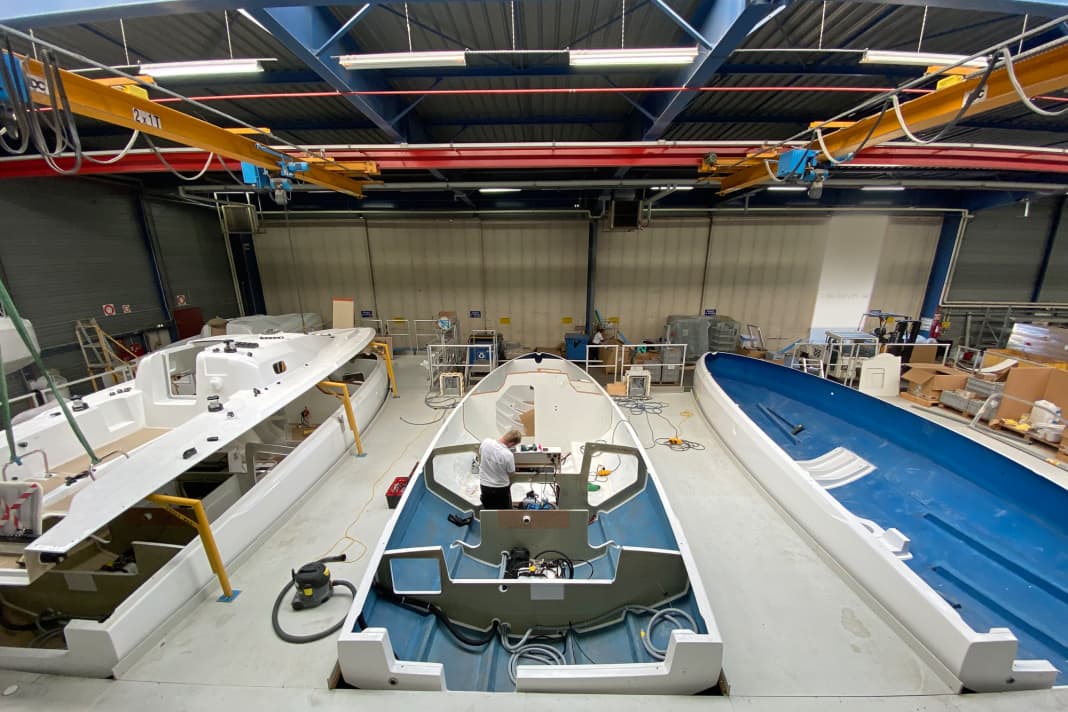





If there is one thing that boat builders and suppliers agree on when it comes to sustainability, it is this: "There is no single solution. It's going to take a whole bunch of very individualised steps." So says Ollie Taylor, Deputy Director of the Anthesis Group, an international consultancy based in London. Taylor has been working for six years on how ships can become more environmentally friendly in their production and utilisation. It is an arduous profession. There are still many in the industry who argue that the impact of the boat market on overall emissions is negligible, says Taylor. "That's why they believe it's not worth thinking about other processes and materials." He believes this is a mistake. After all, even if there is no threat of EU specifications and regulatory intervention for the time being, something is changing.
There is a growing social awareness of the need to reform the old economic model, simply because it no longer works. The boat market in its current form is "a product of the economic upturn of the post-war era, which has brought prosperity to more and more people". In combination with the emergence of GRP series production in the seventies, sailing yachts went from being a luxury for the few to an affordable hobby for hundreds of thousands. "Nobody seriously asked what would happen to the boats when they could no longer find owners," says Taylor. However, this nonchalance is no longer socially acceptable. The next generation is already questioning the status quo. "If we don't offer solutions, it will be difficult."
A number of pioneers have already set out on this path, including some small, innovative start-ups as well as established brands. We present examples of their initiatives and approaches, which are sometimes highly innovative, sometimes tried and tested, sometimes technically complex, sometimes provocatively simple.
Beneteau - a big man thinks big
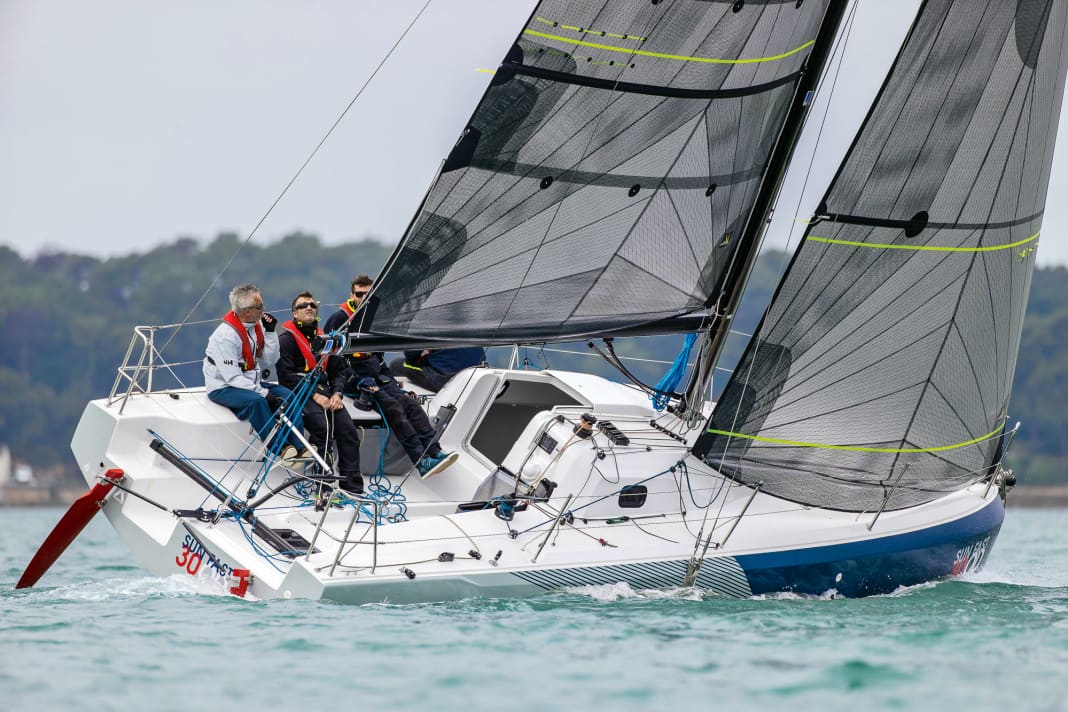





It is to begin in Cheviré, a sober industrial area south of Nantes, one of the many small evolutions that are necessary to significantly reduce the CO2 impact of production boats. The site, which already functioned as a kind of laboratory for ocean sports in the 1980s, back then still under the name Jeanneau Techniques Avancées, is currently building the first series yachts whose hulls are intended to be fully recyclable.
The special shipyard, which measures just 4,000 square metres, belongs to the Beneteau Group. The world's largest sports boat manufacturer by far, with around 7,000 boats from 14-foot dinghies to 76-foot luxury catamarans leaving its halls every year, wants to test here on a small scale what will one day be used on an industrial scale. The pioneer is the Jeanneau 30 One Design a deep-sea racer designed to bridge the gap between the Mini 6.50 and Class 40. It is the Group's first series model to be laminated with Elium instead of polyester resin right from the start. This is an adhesive that hardens into a thermoplastic, liquefies again in a special process and can be reused after being separated from the fibres. "Compared to conventional resins, we can reduce the carbon footprint by 70 percent," says Erwan Faoucher, Beneteau's Research Director and head of the "B sustainable" sustainability programme.
Exclusive insights
In September, YACHT will be granted access to the complex, which otherwise remains strictly shielded, for the first time. Photos are only possible in a few areas; too much preparatory work and development has gone into the process, which promises to alleviate one of the biggest problem areas in boat building. Of course, the process steps are not that different compared to conventional GRP construction. Hulls and decks are produced in negative moulds; they are laminated under vacuum. The only difference is the preparation of the resin, which is delivered in blue drums.
Beneteau's decision to launch the Elium on a racing boat of all things speaks volumes for the company's confidence in the adhesive. Because as a standardised class, the Sun Fast 30 OD unquestionably sailed to the limits of their endurance - incomparably tougher than cruising yachts. It is "the ultimate test", says Damien Jacob, head of the Group's entire sailing boat programme. He is not worried about durability. They also seem unfounded.
The resin is produced by Arkema and has been in use for years, primarily in the construction of wind turbine blades. Enormous centrifugal and shear forces occur at their tips. However, Elium also has to undergo internal tests in Beneteau's own laboratory, which is located an hour's drive south of Nantes in La Roche-sur-Yon.
All building materials are tested
The engineers, chemists and technicians there subject everything that goes into the boats to rigorous testing: Paints, woods, veneers and stainless steel components from the current programme are repeatedly tested for their properties, such as scratch resistance and resistance to UV exposure and weathering. Every batch of gelcoat and resin is tested on delivery before it goes into production. And, of course, everything that is not yet used in series production, such as foam cores made from recycled PET bottles, mats made from hemp fibres grown in Normandy, flax, bio-based resins and, of course, Elium. An effort that no other shipyard makes to this extent. "In this way, we ensure that there are no surprises, which is extremely important, especially with new processes," says Erwan Faoucher. The decision to use more natural fibres such as flax or hemp for small components was also validated over many years in La Roche-sur-Yon.
In the Beneteau Group as a whole, their share is currently less than ten per cent, but is set to increase gradually. The French company is aiming to use 35 per cent bio-based resins this year (2022: 14 per cent). The majority of the upholstery materials for their cushions are already made from recycled fibres. From next year, all waste from GRP production will be sent to the automotive industry for recycling. The company aims to reduce CO2 emissions by 30 per cent overall by 2030 with these and other measures. But Erwan Faoucher is not stopping there.
The Sustainability Director, who has a doctorate in chemistry and economics, not only wants to mobilise the company's own production facilities, but also involve the suppliers. By the end of 2025, more than half of the companies are to undergo the same eco-audit as Beneteau in order to identify - and utilise - potential CO2 savings at all levels of the value chain.
He can rely on a team of 40 employees who provide technical support at all locations in his endeavours to reduce emissions. Together with the government and external consultants, he is currently developing a certification process that will result in an objective CO2 index for every production boat on the market. This would create the transparency that shipyards have so far collectively shied away from.
How far would the market leaders go?
A complex, even bold plan that shows just how far the market leader is prepared to go to achieve the transformation to a more sustainable form of boatbuilding. The prestigious Elium project shows just how complicated this can be. Erwan Faoucher talks about being able to reduce emissions by 70 per cent compared to polyester with the help of the resin. "It's the biggest lever we have in the entire composite sector."
However, the percentage value is viewed critically by experts. On the one hand, because the effect - if any - can only be achieved at the end of the service life and only if the resin is completely recycled. Secondly, because no corresponding processes exist on an industrial scale today. It is therefore a bet on a distant future in 20, 30, 40 or even more years.
There is currently one company that is able to recover Elium: The Swiss start-up is also working on a system for mobile recovery and could use it to recycle hulls and decks in a decentralised manner in the future. However, without long-term financing, a statutory take-back obligation or state subsidies, it is by no means certain that the company will still exist when the yachts one day embark on their final voyage.
The Ecoracer from Eco Yachts
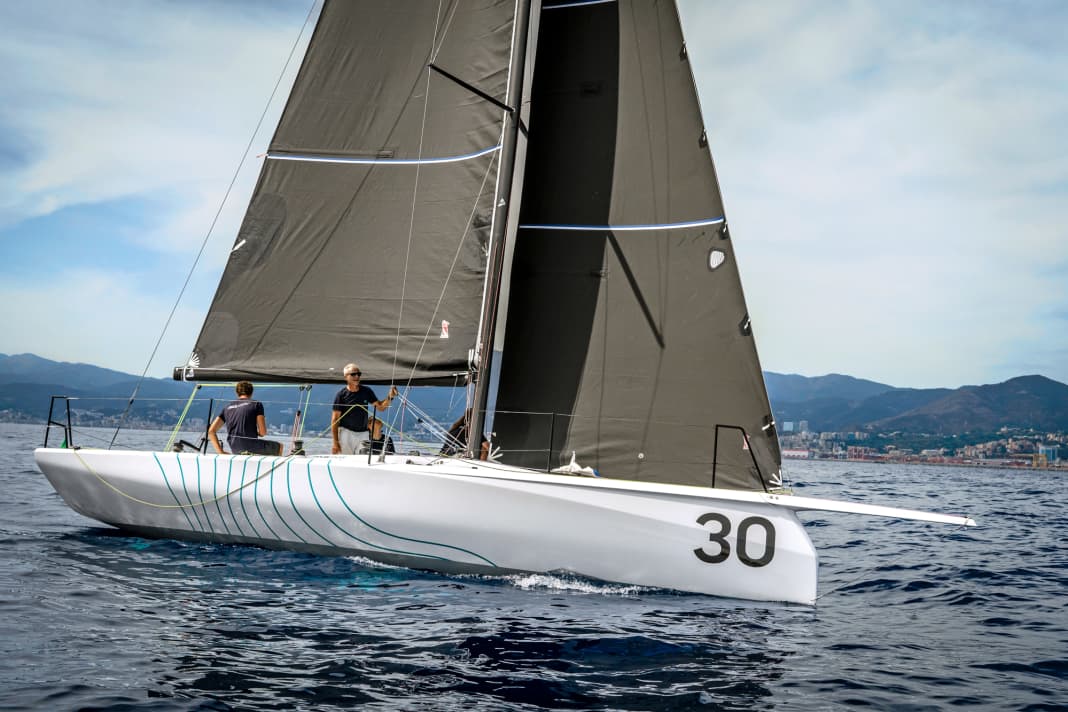


Building completely climate-neutral ships - is that even possible? Yes, say the makers of Northern Light Composites. The think tank in Monfalcone near Trieste has spent the last four years developing a fully recyclable composite material for the boatbuilding industry and has also had the product patented. It has been nominated for the 11th Hour Racing Sustainability Award from the World Sailing Association. The prestigious sustainability award went to Greenboats last year. This year, the Italians are among the finalists.
Under the brand name Eco Yachts, Northern Light Composites also demonstrates what is possible. A prototype, the Ecoracer 25, has already come a long way as a test boat. Matteo Polli's design won the highly competitive Italian sports boat championship last year. It received the special prize for sustainability in the European Yacht of the Year competition.
The larger Ecoracer 30 is now going into series production. The first boat has already been completed and a second is about to be launched. Eco Yachts is also working on the development of a twelve-metre performance cruiser and a pure racer for the Class 40. A series of motor yachts of the same design is also planned.
Specially developed fibre composite system
The recyclability of the hull and deck is achieved by using a fibre composite system called "rComposite" developed by Northern Light Composites specifically for use in boatbuilding. Instead of using thermosetting resins such as polyester, vinyl ester or epoxy, Eco Yachts laminates with a thermoplastic resin that is also used by the Beneteau Group:
Elium. This means that above a certain temperature range, the resin becomes malleable and can thus be separated from a solid fibre composite. In short, the hull and deck can be sawn into their basic components. Mats, core material and resin can then be used to create other, albeit less high-quality components, for example for the construction of moulds or furniture. It's just downcycling, but not the end of the line: waste incineration, park bench or street foundation.
A thermochemical process for splitting the components in the fibre composite is also possible. The resin is separated from the fabric using a special solvent. It can then be reprocessed and reused for composite construction, as can the fibres and the core material. Although hulls can no longer be laminated from this, smaller, non-structural GRP moulded parts such as control columns or covers can be.
Accessibility for other shipyards
Northern Light Composites wants to use the technology behind fibre composite recycling not only for its own Eco Yachts brand, but also to make it available to other interested shipyards. CEO Fabio Bignolini comments: "Ecological sustainability and tackling global environmental problems must be a collective endeavour. By sharing our knowledge and our process, we want to encourage other shipyards to also work together to bring about positive change in yacht building."
Eco Yachts' climate-neutral strategy has now been verified by the independent testing centre Climate Standard. The assessment covers the entire production process, from the procurement of raw materials to the delivery of the boat to the customer. Emissions that cannot be prevented are at least offset by accompanying environmental measures.
As part of its corporate philosophy, which sees transparency as essential to sustainability, Eco Yachts wants to make the certification public. This means that not only the company's customers, but also interested parties from the industry will have access to the data on pollutant emissions and thus be able to track the progress made in reducing emissions. This has been lacking in the water sports sector to date.
Windelo - Newcomer from France
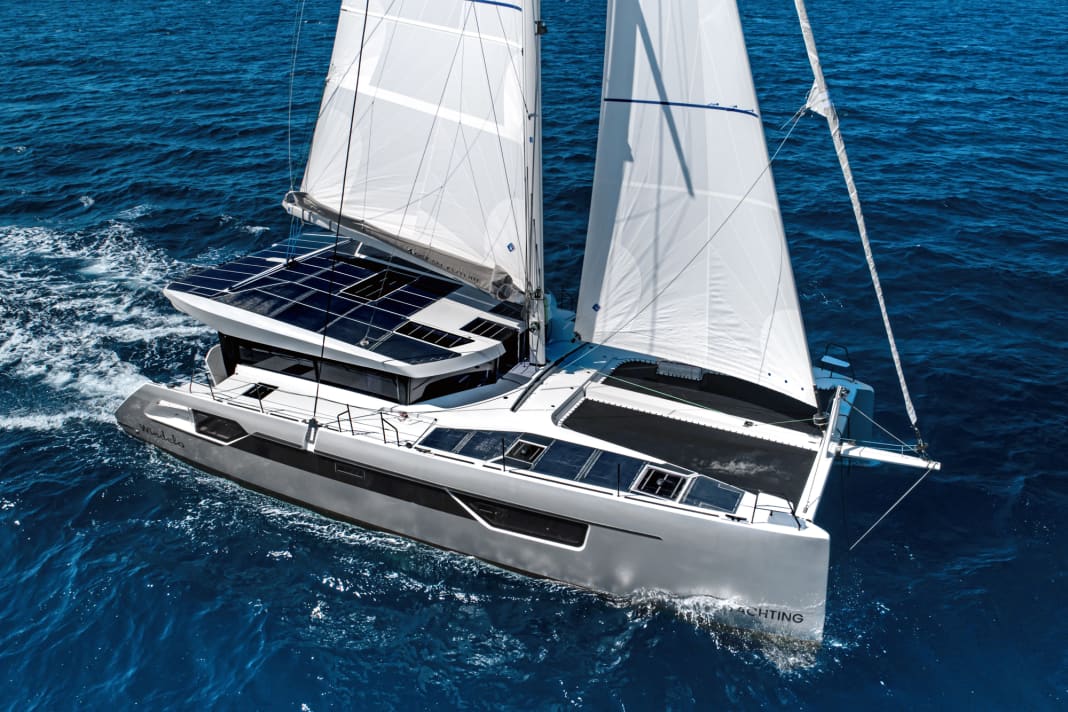


The catamaran manufacturer from the south of France is one of the newcomers on the market, and in many respects is going its own way when it comes to sustainability - far more consistently than any of the established brands. One of the reasons for this was an awakening experience that made the shareholder, a successful entrepreneur, rethink his approach. While visiting an Atlantic island, he saw a mountain of plastic waste in an otherwise unspoilt bay - and decided to do something about it.
Shocked by the direct sight of the sheer quantity of practically indestructible plastic particles, which are otherwise only known from documentaries, he cancelled the planned purchase of a large series catamaran made of GRP. Instead, he researched alternatives. The result was Windelo, the first shipyard to mass-produce twin-hull boats made of basalt fibre and also favour unconventional building materials and systems.
Basalt is basically nothing more than the by-product of a volcanic eruption - cooled lava and also the rock with the widest distribution worldwide. The fibres extracted from it have long since found their way into industrial use, for example as a suitable material for insulation and thermal insulation or as a reinforcing fabric for composite materials, for example for the production of wind turbines.
In yacht building, on the other hand, the use of basalt fibre is still in its infancy. However, this could soon change, especially as production capacities for fibreglass are limited. Windelo is doing pioneering work here, as is Norbert Sedlacek's company Innovation Yachts, which is planning small series production of motorised catamarans after building one-offs and open catamarans.
The material has a number of advantageous properties: Basalt fibre has a significantly higher tensile strength compared to conventional glass fibre. The material is also temperature and fire resistant and insensitive to UV radiation. Above all, however, its production requires hardly any more energy than that of glass fibre. A kind of carbon substitute at an eco-friendly price, if you like. Basalt fibre is produced by melting volcanic rock in blast furnaces. Filaments are drawn from it: long, wafer-thin threads. Woven into mats or fabrics, they can be processed in a similar way to glass fibre.
Plastic drinking bottles as sandwich material
Windelo Catamarans uses a PET core made from recycled plastic drinking bottles as a sandwich material - a construction material that other shipyards have so far only used for non-structural parts. However, around half of the rigid foam panels still need to be reinforced with PVC. This is necessary because the shear strength of PET cores is not yet fully sufficient, at least at present.
With this laminate structure, the innovative French company claims to achieve up to 47 per cent less CO2 equivalent in the production of its catamarans compared to classic GRP sandwiches. This is based on calculations by the university in Alès in the south of France, which provided scientific support and advice to the shipyard during the processing of the basalt fibres.
Windelo deviates from conventional solutions
In addition to the composite construction, Windelo also deviates from conventional solutions in terms of the drive concept and energy supply. The cats are equipped with two large electric motors, each with an output of 20 kW. The power is supplied by two battery banks, each with a capacity of 11 kWh. This is enough to power the boat, which is over 15 metres long and displaces 11.2 tonnes, for just under four hours at a speed of six knots.
Large photovoltaic modules, which are mounted on the roof as well as on deck and produce up to 5 kWh peak power, ensure extensive autonomy while travelling. Additional energy is provided by the propellers running in recuperation mode while sailing. Although their resistance slows the cat by a good knot, the batteries can be fully recharged in this way within a day, provided the speed under sail is permanently around ten knots. Wind generators are also available at extra cost.
Windelo can even boast licensed sustainability for the interior fittings of its catamarans. The shipyard only uses wood from sustainable and certified forestry. Teak decks are not even available on request. The boats are built in Canet-en-Roussillon, not far from the border with Spain. The shipyard currently offers two types, the Windelo 50 and the Windelo 54, with two further models of 47 and 57 feet in length planned.
Bestevaer and Vaan: the green choice
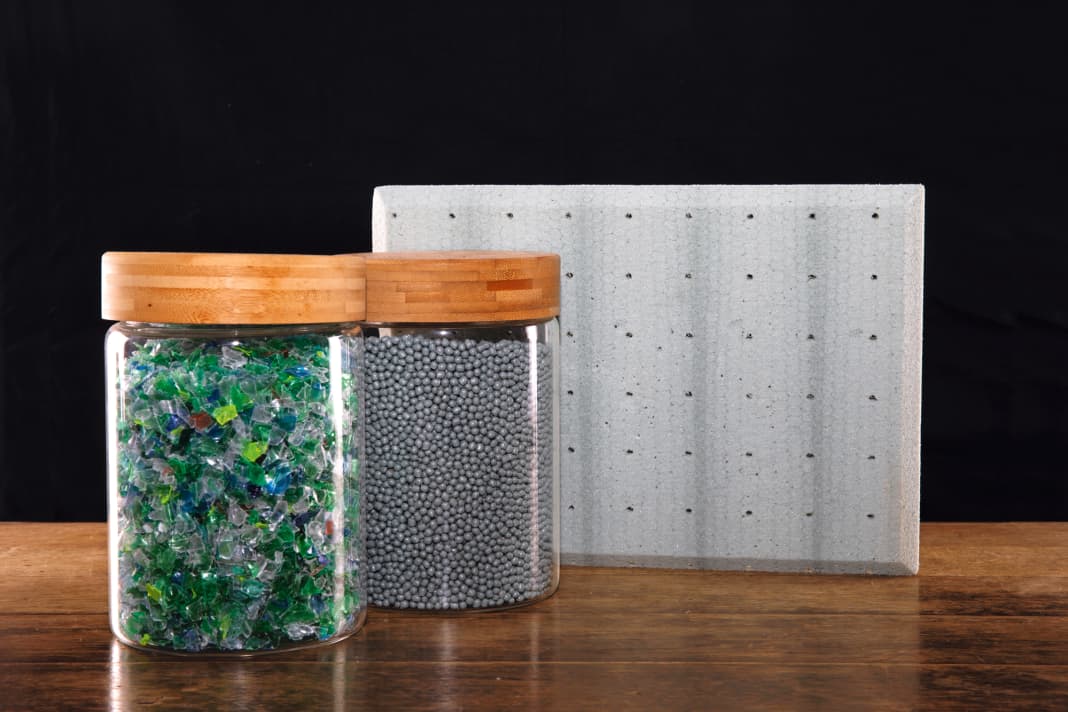


The price list for the new Bestevaer 36 features small green leaves behind various accessory options. They are reminiscent of the symbols for vegan dishes on restaurant menus. The legend reveals that this is a "Green Choice". This is new in boat building. The sustainable extras include the electric drive from Oceanvolt, solar cells and sails from Elvstrøm's Ekko series, which are made from recycled fibres.
The cat builders at Vaan are also fully committed to sustainability: electric drive, recycled materials in the interior, CO2 compensation throughout the entire supply chain. They are serious about it. Sustainability, say the bosses of the aluminium shipyards, is becoming increasingly important. Many customers expect this from their house, their heating system, their car and now even their yacht. Those who can afford it demonstrate this with appropriate products.
Now, it is difficult to "neglect" a yacht in any way when it is made from many tonnes of GRP, which has not yet been reusable in any meaningful way. Aluminium is a completely different matter. Does this provide an answer to the question of how the ecological footprint of boats can be reduced at all - without process innovations whose feasibility will only become apparent in decades?
In any case, the key figures are not that bad: 75 percent of all aluminium ever produced is still in circulation. Fortunately, the light metal can be reused as often as required without losing its properties as a material. It can simply be melted down. This is how ships sail today that used to be window frames, coffee capsules or road signs. The melted material can be alloyed to the 5083 quality required in shipbuilding by adding magnesium, for example. Aluminium of this type can be welded well to very well, has a sufficiently high strength and is also completely resistant to seawater.
Overall balance of the material
As the alloy liquefies at 570 degrees Celsius, the energy required for the recycling process is comparatively low. But what about the overall balance of the material?
This can only be clarified by direct comparison. Firstly, there is glass, made from quartz sand, kaolin, limestone and boric acid. In order to produce long fibres from it, it has to be melted at temperatures of over 1,000 degrees and drawn into hair-thin threads. These in turn can be bundled or woven into fabrics. The primary energy requirement is therefore considerable and recycling has so far been uneconomical. For this reason, GRP construction is one of the areas receiving the most attention in the endeavour to achieve greater sustainability.
Steel is also refractory (at around 1,500 degrees), but would be very easy to recycle. However, it has become almost insignificant as a boat building material because it is heavy and susceptible to corrosion. Wood, on the other hand, has many positive properties. If a ship were built entirely or in large parts from it, it would be ecologically very favourable, as trees bind CO2 from the atmosphere as they grow. However, it is currently always used in combination with resin systems, if at all, due to its better durability in boat building. It is not yet possible to separate resin and wood, which means that the material cannot be reused in the sense of a circular economy. And: the high energy requirement in resin production remains, even if the proportion of adhesive in wood-epoxy construction is significantly lower than in GRP boatbuilding.
There is a lot to be said for aluminium - if it weren't for the enormous effort involved in its original production. An incredible amount of electrical energy is required to produce aluminium from the raw material bauxite: around 16,000 kilowatt hours per tonne - the annual requirement of six households. That alone corresponds to a CO2 equivalent of 6.4 tonnes.
In other words, if a Bestevaer 36, which takes around five tonnes of aluminium to build, were not largely made of recycled material, the construction of the hull and deck alone would pollute the atmosphere with 32 tonnes of CO2. In reality, however, it is only just over a third of this, namely 11.6 tonnes, because the energy required to melt it down is hardly significant.
By way of comparison, a GRP yacht of comparable length has a composite content (resin, fibres) of around 30 percent of the total displacement, or around two tonnes. Around 16 tonnes of CO2 are produced during the manufacture of the construction material; the vast majority is caused by the polyester resin. Aluminium actually performs better in this respect. However, the costs are significantly higher than those of mass-produced plastic yachts due to the more complex construction method.
Aluminium yachts are, to put it with a double negative, as little as possiblenotsustainable. This is because the overall view includes an energy and environmental balance over the entire service life. Here too, boats made of bauxite have the edge, provided they are built and insulated properly. Unlike GRP yachts, the hull needs no protection, no paint, no polish. It itself forms an oxidised layer that protects it from environmental influences.
A plus for the eco-balance
With its latest model, the Bestevaer 36 mentioned here several times, KM Yachtbuilders has shown just how far the advantages of aluminium can be taken. The boat needs neither textured paint nor a coating on deck to ensure the necessary slip resistance. The shipyard has simply glass-bead blasted the bare metal to provide grip for feet or shoe soles. A plus not only for the eco-balance, but also for the owners, who save on maintenance costs and follow-up investments in the long term thanks to this simple and ingenious measure.
This art of reduction has been almost completely lost to boatbuilding in the longer-bigger-better fever of recent decades. Here it was a design principle. It may seem unsettling to see and feel the unconcealed rawness of the material everywhere. But this is precisely where the benefits lie.
You can spend a long time discussing and calculating whether the electric drive, which is available at extra cost, actually has a positive impact on the eco-balance or whether it is more of a burden. After all, unlike electric cars that are driven a lot and perform better than highly efficient combustion engines after just 70,000 to 90,000 kilometres, yachts rarely achieve the operating hours required for a real net benefit - and if they do, then only after many years, when inverters, controllers and batteries may already need to be replaced.
An indisputable point
In one respect, however, the Bestevaer 36 undeniably shows how sustainability works. And it has only indirectly to do with the components on board or the aluminium construction material: designer Gerard Dykstra and his clients at KM kept an iron grip.
While the majority of the market has long since levelled off above 40 feet, where bow and sometimes stern thrusters are now almost the norm, where electric sheet winches are either already fitted as standard or ordered as an option as a matter of course, the Dutch have stuck with a human-sized boat on which the main can still be set hand over hand if things have to be done quickly.
No process, no building material will ever be completely emission-free. However, eliminating one or two metres of hull length saves several times over because the effect is felt throughout the entire boat: It not only means less aluminium or GRP, but also fewer working hours, a shorter mast profile, less ballast, shorter cables, smaller fittings, less removal. In this respect, the Bestevaer 36 is also a "green choice".
Further topics in the sustainability special:
- 25 tips to help you sail more environmentally friendly
- These projects are available for marine conservation
- Sailing yacht vs. motorboat: which model is more sustainable?
- Shipyard portrait Greenboats: Boats made of flax and components for Boris Herrmann
- Sustainable fashion: oilskins and other functional clothing - the best products
- Boat recycling: the never-ending story of GRP
- Sail recycling: not just stylish bags - what happens to old cloth
- "Losing is not an option" - Boris Herrmann on sustainability in motorsport
- Sustainable management: Wooden boats in charter operations
- Equipment: Every sailor should reach for these green alternatives
- Drinking water on board: you can filter water correctly using these methods
- Baltic Sea: How does a harbour become sustainable?
- Research yachts: Climate protectors under sail
- Pallets, bottles, flip-flops: creative recycling ideas in boatbuilding
- Monsoon 31: Greenfit instead of refit, what does that mean for the 50-year-old Hallberg-Rassy?
- "Nomade des Mers": a catamaran as a low-tech laboratory
- Self-build yacht "Ya": Totally self-sufficient on a trip around the world
- Sustainable boat project: 55-foot catamaran made from recycled aluminium
- The Schwörer family and the "Pachamama": on a long voyage for climate protection
- Nike Steiger on her recycling project

